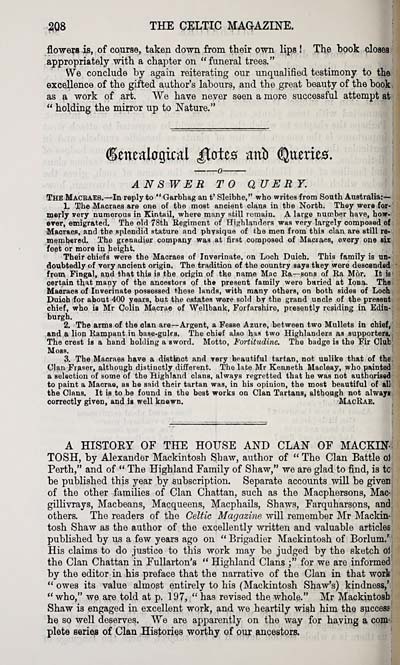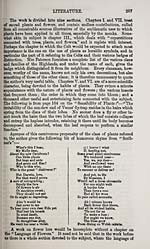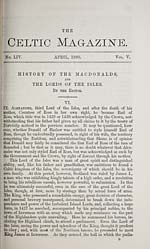Blair Collection > Celtic magazine > Volume 5
(218)
Download files
Complete book:
Individual page:
Thumbnail gallery: Grid view | List view

208 THE CELTIC MAGAZINE.
flo-wers is, of course, taken down from their own lips ! The book closes
appropriately with a chapter on "funeral trees."
We conclude by again reiterating our unqualified testimony to the
excellence of the gifted author's labours, and the great beauty of the book
as a work of art. We have never seen a more successful attempt at
" holding the mirror up to Nature."
^enealoQiral £iott!S mil) %izxizs,
ANSWER TO QUERY.
The Macraes, — In reply to " Garbhag an t' Sleibhe," who writes from South Australia:— ' i
1. The Macraes are one of the most ancient clans in the North. They were for- ' ,;
merly very numerous in Kintail, where many still remain. A large number have, how- |
ever, emigrated. The old 78th Regiment of Hip;blander3 was very largely composed of: ^
Macraes, and the splendid stature and physique of the men from this clan are still ra. , I
reembered. The grenadier company was at first composed of Macraes, every one six,
feet or more in height. . . •
Their chiefs were the Macraes of Inverinate, on Loch Duich. This family is un- ;
doubtedly of very ancient origin. The tradition of the country says they were descended • •■!
from Fingal, and that this is the origin of the name Mac Ra— sons of Ra Mor. It isj |
certain that many of the ancestors of the present family were buried at lona. Thai '
Maoraes of Inverinate possessed these lands, with many others, on both sides of Loch j >
Duioh for about 400 years, but the estates were sold by the grand uncle of the present i y
chief, who is Mr Colin Macrae of Wellbank, Forfarshire, presently residing in Edin-,' t
burgh.
2. The arms of the clan are— Argent, a Fesse Azure, between two Mullets in chief,' i
and a lion Rampant in base-gulf a. The chief also has two Highlanders as supporter!. J i
The crest is a hand holding a sword. Motto, Fortitudine. The badge is the Fir Olu1b' ^
Moss. :
3. The Macraes have a distinct and very beautiful tartan, not unlike that of the,
Clan Fraser, although distinctly different. The late Mr Kenneth Macleay, who painted i i
a selection of some of the Highland clans, always regretted that he was not authoriasdi •
to paint a Macrae, as he said their tartan was, in his opinion, the most beautiful of all ' 1
the Clans. It is to be found in the best works on Clan Tartans, although not alwayi) 1
correctly given, and is well knewn. MacRab. : ]
A HISTORY OF THE HOUSE AND CLAN OF MACKIN: (
TOSH, by Alexander Mackintosh Shaw, author of " The Clan Battle ol i
Perth," and of " The Highland Family of Shaw," we are glad to find, is tc; i
be published this year by subscription. Separate accounts will be given! 'i
of the other families of Clan Chattan, such as the Macphersons, Mac-j J
gillivrays, Macbeans, Macqueens, Macphails, Shaws, Farquharsons, andj ;'
others. The readers of the Celtic Magazine will remember Mr Mackin- I
tosh Shaw as the author of the excellently written and valuable articles »i
published by us a few years ago on "Brigadier Mackintosh of Borlum."! i
His claims to do justice to this work may be judged by the sketch oi f
the Clan Chattan in Fullarton'a " Highland Clans ;" for we are informed i
by the editor in his preface that the narrative of the Clan ia that worh! i
" owes its value almost entirely to his (Mackintosh Shaw's) kindness,' i
" who," we are told at p. 197, " has revised the whole." Mr Mackintosh f
Shaw is engaged in excellent work, and we heartily wish him the success! ;
he so well deserves. We are apparently on the way for having a com-. J
plete series of Clan Histories worthy of our ancestors.
I
flo-wers is, of course, taken down from their own lips ! The book closes
appropriately with a chapter on "funeral trees."
We conclude by again reiterating our unqualified testimony to the
excellence of the gifted author's labours, and the great beauty of the book
as a work of art. We have never seen a more successful attempt at
" holding the mirror up to Nature."
^enealoQiral £iott!S mil) %izxizs,
ANSWER TO QUERY.
The Macraes, — In reply to " Garbhag an t' Sleibhe," who writes from South Australia:— ' i
1. The Macraes are one of the most ancient clans in the North. They were for- ' ,;
merly very numerous in Kintail, where many still remain. A large number have, how- |
ever, emigrated. The old 78th Regiment of Hip;blander3 was very largely composed of: ^
Macraes, and the splendid stature and physique of the men from this clan are still ra. , I
reembered. The grenadier company was at first composed of Macraes, every one six,
feet or more in height. . . •
Their chiefs were the Macraes of Inverinate, on Loch Duich. This family is un- ;
doubtedly of very ancient origin. The tradition of the country says they were descended • •■!
from Fingal, and that this is the origin of the name Mac Ra— sons of Ra Mor. It isj |
certain that many of the ancestors of the present family were buried at lona. Thai '
Maoraes of Inverinate possessed these lands, with many others, on both sides of Loch j >
Duioh for about 400 years, but the estates were sold by the grand uncle of the present i y
chief, who is Mr Colin Macrae of Wellbank, Forfarshire, presently residing in Edin-,' t
burgh.
2. The arms of the clan are— Argent, a Fesse Azure, between two Mullets in chief,' i
and a lion Rampant in base-gulf a. The chief also has two Highlanders as supporter!. J i
The crest is a hand holding a sword. Motto, Fortitudine. The badge is the Fir Olu1b' ^
Moss. :
3. The Macraes have a distinct and very beautiful tartan, not unlike that of the,
Clan Fraser, although distinctly different. The late Mr Kenneth Macleay, who painted i i
a selection of some of the Highland clans, always regretted that he was not authoriasdi •
to paint a Macrae, as he said their tartan was, in his opinion, the most beautiful of all ' 1
the Clans. It is to be found in the best works on Clan Tartans, although not alwayi) 1
correctly given, and is well knewn. MacRab. : ]
A HISTORY OF THE HOUSE AND CLAN OF MACKIN: (
TOSH, by Alexander Mackintosh Shaw, author of " The Clan Battle ol i
Perth," and of " The Highland Family of Shaw," we are glad to find, is tc; i
be published this year by subscription. Separate accounts will be given! 'i
of the other families of Clan Chattan, such as the Macphersons, Mac-j J
gillivrays, Macbeans, Macqueens, Macphails, Shaws, Farquharsons, andj ;'
others. The readers of the Celtic Magazine will remember Mr Mackin- I
tosh Shaw as the author of the excellently written and valuable articles »i
published by us a few years ago on "Brigadier Mackintosh of Borlum."! i
His claims to do justice to this work may be judged by the sketch oi f
the Clan Chattan in Fullarton'a " Highland Clans ;" for we are informed i
by the editor in his preface that the narrative of the Clan ia that worh! i
" owes its value almost entirely to his (Mackintosh Shaw's) kindness,' i
" who," we are told at p. 197, " has revised the whole." Mr Mackintosh f
Shaw is engaged in excellent work, and we heartily wish him the success! ;
he so well deserves. We are apparently on the way for having a com-. J
plete series of Clan Histories worthy of our ancestors.
I
Set display mode to: Large image | Transcription
Images and transcriptions on this page, including medium image downloads, may be used under the Creative Commons Attribution 4.0 International Licence unless otherwise stated. ![]()
| Early Gaelic Book Collections > Blair Collection > Celtic magazine > Volume 5 > (218) |
|---|
| Permanent URL | https://digital.nls.uk/76451450 |
|---|
| Description | Volume V, 1880. |
|---|---|
| Shelfmark | Blair.6 |
| Attribution and copyright: |
|
| Description | A selection of books from a collection of more than 500 titles, mostly on religious and literary topics. Also includes some material dealing with other Celtic languages and societies. Collection created towards the end of the 19th century by Lady Evelyn Stewart Murray. |
|---|
| Description | Selected items from five 'Special and Named Printed Collections'. Includes books in Gaelic and other Celtic languages, works about the Gaels, their languages, literature, culture and history. |
|---|

